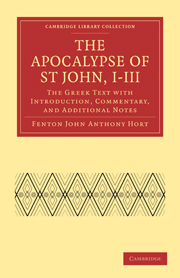Book contents
INTRODUCTION
Published online by Cambridge University Press: 05 October 2010
Summary
THREE things most desirable to know about an ancient writing, Author, Readers, and Time.
In many cases the Readers are of little consequence: but not so where their circumstances have evidently determined much of what is said. In this case the Readers are clearly defined: and what there is to be said about them may be deferred for the present.
But the Author and the Time are matters of warm controversy, and to a great extent the two subjects are mixed up together, though, on one side at least, there is no necessary connexion.
As a starting-point we may take the traditional view, which contains in itself several statements. “John, the son of Zebedee, the author of the Gospel and Epistles bearing his name, wrote also the Apocalypse in the reign of Domitian.” Since the Apocalypse was certainly due to persecution, and no persecution of Christians in Domitian's reign is known except at its very end, the date must on this view be 95 or 96, as he was killed in September, 96.
Now at the outset it should be observed that no part of this composite statement can appeal to the direct and express testimony of the N.T. Of course the words “direct and express” are everything. But neither the Gospel nor the Epistles contain within themselves the name of their author: the titles are no part of them.
- Type
- Chapter
- Information
- The Apocalypse of St John, I–IIIThe Greek Text with Introduction, Commentary, and Additional Notes, pp. ix - xlivPublisher: Cambridge University PressPrint publication year: 2010First published in: 1908



